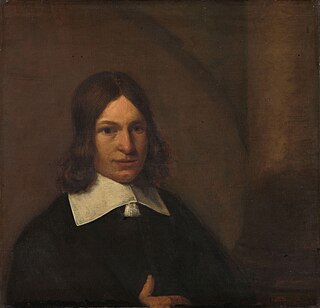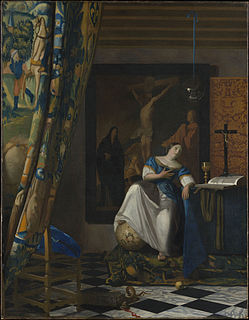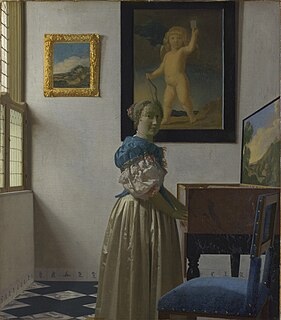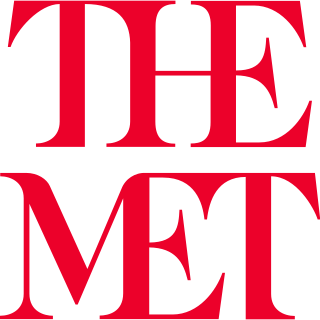
Henricus Antonius "Han" van Meegeren was a Dutch painter and portraitist and is considered to be one of the most ingenious art forgers of the 20th century. Despite his life of crime, van Meegeren became a national hero after World War II when it was revealed that he had sold a forged painting to Reichsmarschall Hermann Göring during the Nazi occupation of the Netherlands.

Carel Pietersz. Fabritius was a Dutch painter. He was a pupil of Rembrandt and worked in his studio in Amsterdam. Fabritius, who was a member of the Delft School, developed his own artistic style and experimented with perspective and lighting. Among his works are A View of Delft (1652), The Goldfinch (1654), and The Sentry (1654).

Pieter de Hooch was a Dutch Golden Age painter famous for his genre works of quiet domestic scenes with an open doorway. He was a contemporary of Jan Vermeer in the Delft Guild of St. Luke, with whom his work shares themes and style.

Esaias Boursse, was a Dutch painter. His paintings were mainly genre works.

The Little Street is a painting by the Dutch painter Johannes Vermeer, executed c. 1657–58. It is exhibited at the Rijksmuseum of Amsterdam, and signed, below the window in the lower left-hand corner, "I V MEER".

The Milkmaid, sometimes called The Kitchen Maid, is an oil-on-canvas painting of a "milkmaid", in fact, a domestic kitchen maid, by the Dutch artist Johannes Vermeer. It is now in the Rijksmuseum in Amsterdam, the Netherlands, which regards it as "unquestionably one of the museum's finest attractions".

A Lady Writing a Letter is an oil painting attributed to 17th century Dutch painter Johannes Vermeer. It is believed to have been completed around 1665. The Lady is seen to be writing a letter and has been interrupted, so gently turns her head to see what is happening. She wears twelve pearls.

Girl with a Pearl Earring is an oil painting by Dutch Golden Age painter Johannes Vermeer, dated c. 1665. Going by various names over the centuries, it became known by its present title towards the end of the 20th century after the large pearl earring worn by the girl portrayed there. The work has been in the collection of the Mauritshuis in The Hague since 1902 and has been the subject of various literary treatments. In 2006, the Dutch public selected it as the most beautiful painting in the Netherlands.

The Love Letter is a 17th-century genre painting by Jan Vermeer. The painting shows a servant maid handing a letter to a young woman with a cittern. The painting is in the Rijksmuseum Amsterdam.

Study of a Young Woman is a painting by the Dutch artist Johannes Vermeer, completed between 1665 and 1667, and now in the Metropolitan Museum of Art, New York.

The Allegory of Faith, also known as Allegory of the Catholic Faith, is a painting created by Dutch artist Johannes Vermeer in about 1670–72. The painting is currently located at the Metropolitan Museum of Art in New York, and has been since 1931.

Woman with a Lute, also known as Woman with a Lute Near a Window, is a painting created about 1662–1663 by Dutch painter Johannes Vermeer and now at the Metropolitan Museum of Art in New York.

Lady Standing at a Virginal is a genre painting created by the Dutch artist Johannes Vermeer in about 1670–1672, now in the National Gallery, London.

Officer and Laughing Girl, also known as Officer and a Laughing Girl, Officer With a Laughing Girl or De Soldaat en het Lachende Meisje, was painted by the Dutch artist Johannes Vermeer between 1655 and 1660. It was painted in oil on canvas, typical of most Dutch artists of the time, and is 50.5 by 46 cm. It now resides in The Frick Collection in New York.

Woman Holding a Balance, also called Woman Testing a Balance, is an oil painting by Dutch Golden Age artist Johannes Vermeer.

Girl Reading a Letter at an Open Window is an oil painting by Dutch Golden Age painter Johannes Vermeer. Completed in approximately 1657–59, the well-preserved painting is on display at the Gemäldegalerie in Dresden. For many years, the attribution of the painting—which features a young Dutch woman reading a letter before an open window—was lost, with first Rembrandt and then Pieter de Hooch being credited for the work before it was properly identified in 1880. After World War II, the painting was briefly in possession of the Soviet Union.
Jacob Abrahamsz. Dissius was a Dutch typographer and printer. He is most notable as an art collector and for his links to Johannes Vermeer - his collection included 21 Vermeer works and in 1680 he married Madgdalene, daughter and sole heir of Vermeer's main patron Pieter van Ruijven. Dissius died in 1695 and his collection was auctioned off in Amsterdam the following year.

Woman with a Pearl Necklace by Johannes Vermeer is a seventeenth-century Northern European painting. Painted in oils on canvas, Johannes Vermeer portrayed a young Dutch woman, most likely of upper-class-descent, dressing herself with two yellow ribbons, pearl earrings, and a pearl necklace. As a very popular artist of the 17th century, the Dutch Golden Age, Vermeer depicted many women in similar circumstances within interior, domestic scenes. The same woman also appears in The Love Letter and A Lady Writing a Letter.

Girl with a Flute is a small painting attributed to the Dutch Golden Age painter Johannes Vermeer, executed 1665–1670. The work is in possession of the National Gallery of Art in Washington, D.C., just as Woman Holding a Balance, A Lady Writing a Letter and Girl with a Red Hat.























